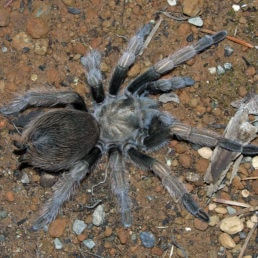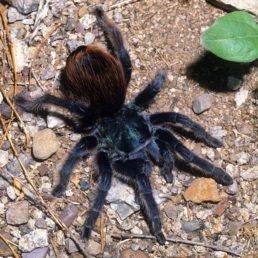Taxonomic Hierarchy
- Kingdom: Animalia
- Phylum: Arthropoda
- Class: Arachnida
- Order: Araneae
- Suborder: Mygalomorphae
- Family: Theraphosidae
- Genus: Aphonopelma
- Species: Aphonopelma seemanni
Other Common Names
Costa Rican Zebra Tarantula
Author
(F. O. Pickard-Cambridge, 1897)
Primary Colors
Sightings Overview
There have been 1 confirmed sightings of Aphonopelma seemanni (Costa Rican Zebra Tarantula), with the most recent sighting submitted on November 20, 2019 by Spider ID member rickcwest. The detailed statistics below may not utilize the complete dataset of 1 sightings because of certain Aphonopelma seemanni sightings reporting incomplete data.
- Web: 0% of the time, Aphonopelma seemanni spiders are sighted in a spider web (Sample size: 1)
- Sex: 1 female and 0 male.
- Environment: Aphonopelma seemanni has been sighted 2 times outdoors, and 0 times indoors.
- Outdoors: Ground layer (1). Open field, pasture, grassland (1).
Location and Range
Aphonopelma seemanni (Costa Rican Zebra Tarantula) has been sighted in the following countries: Costa Rica.
Seasonality
Aphonopelma seemanni has been primarily sighted during the month of September.
- January:
- February:
- March:
- April:
- May:
- June:
- July:
- August:
- September: 1
- October:
- November:
- December:
Additional Remarks
Type species.
 The spider species Aphonopelma seemanni, commonly known as Costa Rican Zebra Tarantula, belongs to the genus Aphonopelma, in the family Theraphosidae. Aphonopelma seemanni spiders have been sighted
The spider species Aphonopelma seemanni, commonly known as Costa Rican Zebra Tarantula, belongs to the genus Aphonopelma, in the family Theraphosidae. Aphonopelma seemanni spiders have been sighted 
